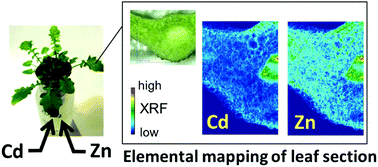当前位置:
X-MOL 学术
›
Metallomics
›
论文详情
Our official English website, www.x-mol.net, welcomes your feedback! (Note: you will need to create a separate account there.)
Visible cellular distribution of cadmium and zinc in the hyperaccumulator Arabidopsis halleri ssp. gemmifera determined by 2-D X-ray fluorescence imaging using high-energy synchrotron radiation.
Metallomics ( IF 3.4 ) Pub Date : 2019-12-17 , DOI: 10.1039/c9mt00243j Naoki Fukuda 1 , Nobuyuki Kitajima , Yasuko Terada , Tomoko Abe , Izumi Nakai , Akiko Hokura
Metallomics ( IF 3.4 ) Pub Date : 2019-12-17 , DOI: 10.1039/c9mt00243j Naoki Fukuda 1 , Nobuyuki Kitajima , Yasuko Terada , Tomoko Abe , Izumi Nakai , Akiko Hokura
Affiliation

|
The striking sub-cellular distribution of cadmium (Cd) and zinc (Zn) in the Cd and Zn hyperaccumulator Arabidopsis halleri ssp. gemmifera was revealed by microbeam X-ray microfluorescence analysis (μ-XRF) using high-energy synchrotron radiation. Plants were grown in hydroponics with various Cd and Zn concentrations. The concentration of Cd in the aerial portions of the plants increased with increasing Zn exposure and the transportation efficiency of Cd from the root to the shoot was affected by both the Cd and Zn concentrations in the nutrient solution. The μ-XRF imaging clearly showed that Cd and Zn were preferentially accumulated in trichomes on the leaf, while the distribution of Cd in the leaf was changed by Zn treatment. It was observed that Cd treated with a higher Zn concentration (20 μM Cd + 100 μM Zn) was distributed in the mesophyll tissue at high concentrations. In addition, μ-XRF imaging clarified that the distribution of Zn inside the leaf was different from that of Cd at a cellular level. Zn was primarily distributed in the mesophyll tissue of the leaf blade. In contrast, Cd was localized in the vascular bundle of the main vein. That is, Zn was transported to mesophyll tissue from the vascular bundle more efficiently than Cd. As seen above, we were able to study the difference of the distribution of Cd and Zn, which are congeners and behave similarly, inside the plant body at the cellular level in detail by high-energy μ-XRF.
中文翻译:

镉和锌在超级蓄积拟南芥中的可见细胞分布。通过使用高能同步加速器辐射的2-D X射线荧光成像确定的双子叶植物。
镉和锌超蓄积拟南芥中特别显着的镉(Cd)和锌(Zn)的亚细胞分布。通过使用高能同步加速器辐射的微束X射线微荧光分析(μ-XRF)揭示了宝石双生。使植物在具有不同Cd和Zn浓度的水培法中生长。营养液中的Cd和Zn浓度均会影响植物中空气中Cd的浓度,这与Zn暴露量的增加有关。Cd从根部到苗的运输效率受其影响。μ-XRF成像清楚地表明,叶片中的毛状体中Cd和Zn优先积累,而Zn处理改变了Cd在叶片中的分布。观察到,以较高的锌浓度(20μMCd + 100μMZn)处理的Cd以高浓度分布在叶肉组织中。此外,μ-XRF成像表明,在细胞水平上,叶片内Zn的分布与Cd的分布不同。锌主要分布在叶片的叶肉组织中。相反,Cd定位在主静脉的血管束中。即,Zn比Cd更有效地从血管束转运到叶肉组织。如上所示,我们能够通过高能μ-XRF技术详细研究细胞体内Cd和Zn的分布差异,Cd和Zn的同源性和行为相似。μ-XRF成像表明,在细胞水平上,叶片内Zn的分布与Cd的分布不同。锌主要分布在叶片的叶肉组织中。相反,Cd定位在主静脉的血管束中。即,Zn比Cd更有效地从血管束转运到叶肉组织。如上所示,我们能够通过高能μ-XRF技术详细研究细胞体内Cd和Zn的分布差异,Cd和Zn的同源性和行为相似。μ-XRF成像表明,在细胞水平上,叶片内Zn的分布与Cd的分布不同。锌主要分布在叶片的叶肉组织中。相反,Cd定位在主静脉的血管束中。即,Zn比Cd更有效地从血管束转运到叶肉组织。如上所示,我们能够通过高能μ-XRF技术详细研究细胞体内Cd和Zn的分布差异,Cd和Zn的同源性和行为相似。
更新日期:2020-02-27
中文翻译:

镉和锌在超级蓄积拟南芥中的可见细胞分布。通过使用高能同步加速器辐射的2-D X射线荧光成像确定的双子叶植物。
镉和锌超蓄积拟南芥中特别显着的镉(Cd)和锌(Zn)的亚细胞分布。通过使用高能同步加速器辐射的微束X射线微荧光分析(μ-XRF)揭示了宝石双生。使植物在具有不同Cd和Zn浓度的水培法中生长。营养液中的Cd和Zn浓度均会影响植物中空气中Cd的浓度,这与Zn暴露量的增加有关。Cd从根部到苗的运输效率受其影响。μ-XRF成像清楚地表明,叶片中的毛状体中Cd和Zn优先积累,而Zn处理改变了Cd在叶片中的分布。观察到,以较高的锌浓度(20μMCd + 100μMZn)处理的Cd以高浓度分布在叶肉组织中。此外,μ-XRF成像表明,在细胞水平上,叶片内Zn的分布与Cd的分布不同。锌主要分布在叶片的叶肉组织中。相反,Cd定位在主静脉的血管束中。即,Zn比Cd更有效地从血管束转运到叶肉组织。如上所示,我们能够通过高能μ-XRF技术详细研究细胞体内Cd和Zn的分布差异,Cd和Zn的同源性和行为相似。μ-XRF成像表明,在细胞水平上,叶片内Zn的分布与Cd的分布不同。锌主要分布在叶片的叶肉组织中。相反,Cd定位在主静脉的血管束中。即,Zn比Cd更有效地从血管束转运到叶肉组织。如上所示,我们能够通过高能μ-XRF技术详细研究细胞体内Cd和Zn的分布差异,Cd和Zn的同源性和行为相似。μ-XRF成像表明,在细胞水平上,叶片内Zn的分布与Cd的分布不同。锌主要分布在叶片的叶肉组织中。相反,Cd定位在主静脉的血管束中。即,Zn比Cd更有效地从血管束转运到叶肉组织。如上所示,我们能够通过高能μ-XRF技术详细研究细胞体内Cd和Zn的分布差异,Cd和Zn的同源性和行为相似。



























 京公网安备 11010802027423号
京公网安备 11010802027423号